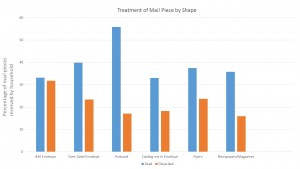Part of our series where we seek to uncover the most effective formats for your specific marketing objectives.

A standard postcard 4.25 x 6″ in dimension may seem small, but it’s the perfect size for a quick message that’s easy to read, and it still stands above a standard #10 envelope.
A Postcard, Defined
A postcard is a card that mails without an envelope or folded element.
The United States Postal Service (USPS) has a special First Class Postcard postage rate for postcards that fall within the following criteria:
- Rectangular
- At least 3-1/2” high x 5” long x 0.007” thick
- No more than 4-1/2” high x 6” long x 0.016” thick
Postcards that do not fit within this criteria qualify as letters in USPS’s eyes, and letter postage rates apply.
Why Send a Postcard?
- Postcards are cost effective. The straightforward format simplifies production compared to other formats such as letter packs, which require envelopes, folding, inserting and sealing.
- They ensure your message is seen—by many. Without the barrier of an envelope, postcards require little effort from the consumer in reading your message. Not to mention, when it rests on someone’s counter or desk, all who walk past are also exposed to your message and branding.
- They are versatile. By ordering an extra boxful of generics during your postcard mailing, you have a cheap and effective flyer, business card, or informational piece to use as needed.
- They are convenient for the recipient. Usually printed on card stock (80-100# cover), they aren’t easily torn or bent, so they can have a long physical shelf-life. Recipients often hang onto postcards for later reference especially when there is a great offer provided.
Why You Shouldn’t Send a Postcard?
- Postcards offer a limited amount of space. You only get a front and a back. And don’t forget you need to save room for the address block! Standard sized postcards also can tend to get “lost” among larger pieces of mail.
- They offer no privacy. Forget about including your customer’s personal account information if you’re sending a postcard. Your message is out for the world to see.
- There is no physical reply function. With a letter pack, you can enclose a reply card and even a reply envelope. With a postcard, your response hinges on the power of your offer to compel an action beyond the physical piece.
- They are cheap. This pro may also be a con, depending on your brand. If you are trying to create a high-end or exceedingly professional brand reputation, a cheap postcard may diminish your authority, whereas a nicely written personalized letter can provide a more professional touch.
Best Uses for the Postcard – Retail
The retail industry is especially well-suited for postcard mailings, because it comes as no surprise to the recipient that they are one of a million others who are to receive the same thing. Although personalization gives retail mailers a definite advantage, a good offer and a quick message might just outweigh the necessity of the personal touch.
For example, when a froyo lover gets a postcard with an offer for a dollar off their next bowl, do you think they care that the marketer didn’t take the time to send them something more elaborate to them? Probably not! They’re probably going to stick the card on the fridge and plan their next froyo trip.
Two applications for postcards that we’ve seen become a powerful force for our customers are loyalty programs and reminder programs. Both require brief messaging and just enough room for a great promo—which makes a 4.25 x 6” postcard just the right amount of real estate.
Let the Stats Speak for Themselves


The USPS’ 2013 Household Diary Study found postcards to continually be the most read format of direct mail, and one of the least discarded in comparison to letter packs, catalogs, newspapers, and flyers. The households studied claimed that approximately 50.7% of the postcards they received were “useful,” which was only a close third to catalogs and newspapers, which offer heavier content. The study also exposes a greater likelihood of response to postcards over the other formats.
If we think about which types of mailers make up the postcard population, these stats make sense; they are most often quick-decision companies, like vehicle service centers and grocers, where the competition is high, and a simple coupon can make all the difference in the consumer’s decision making process. It makes sense that a small, easily digestible and redeemable coupon delivered via postcard would easily garner the intended response.
Top Takeaways with Postcards
- They’re easy to read and easy to throw away.
- If your business has a short sales funnel and quick turnover, postcards could very well be a cheap revenue driver.
- If your call-to-action is easily understood and doesn’t require a separate reply function, the same may apply.
Finding the right format is about understanding your objective: if your message needs to be quick and useful to your recipient, postcards might just be your #1 choice in format for your mail campaign.





